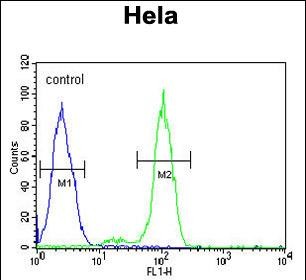PTPLB Antibody (C-term)
Affinity Purified Rabbit Polyclonal Antibody (Pab)
- SPECIFICATION
- CITATIONS
- PROTOCOLS
- BACKGROUND

Application
| WB, FC, IHC-P, E |
|---|---|
| Primary Accession | Q6Y1H2 |
| Other Accession | Q2KIP8, NP_940684 |
| Reactivity | Human |
| Predicted | Bovine |
| Host | Rabbit |
| Clonality | Polyclonal |
| Isotype | Rabbit IgG |
| Calculated MW | 28368 Da |
| Antigen Region | 226-254 aa |
| Gene ID | 201562 |
|---|---|
| Other Names | Very-long-chain (3R)-3-hydroxyacyl-CoA dehydratase 2, 3-hydroxyacyl-CoA dehydratase 2, HACD2, Protein-tyrosine phosphatase-like member B, PTPLB, HACD2 |
| Target/Specificity | This PTPLB antibody is generated from rabbits immunized with a KLH conjugated synthetic peptide between 226-254 amino acids from the C-terminal region of human PTPLB. |
| Dilution | WB~~1:1000 FC~~1:10~50 IHC-P~~1:50~100 E~~Use at an assay dependent concentration. |
| Format | Purified polyclonal antibody supplied in PBS with 0.09% (W/V) sodium azide. This antibody is purified through a protein A column, followed by peptide affinity purification. |
| Storage | Maintain refrigerated at 2-8°C for up to 2 weeks. For long term storage store at -20°C in small aliquots to prevent freeze-thaw cycles. |
| Precautions | PTPLB Antibody (C-term) is for research use only and not for use in diagnostic or therapeutic procedures. |
| Name | HACD2 {ECO:0000303|PubMed:18554506, ECO:0000312|HGNC:HGNC:9640} |
|---|---|
| Function | Catalyzes the third of the very long-chain fatty acids (VLCFA) elongation four-step cycle (condensation, reduction, dehydration, and reduction). This endoplasmic reticulum-elongation process is characterized by the addition of two carbons to the lipid chain through each cycle. This enzyme catalyzes the dehydration of the 3-hydroxyacyl-CoA intermediate into trans-2,3-enoyl-CoA, within each cycle of elongation. Therefore, it participates in the production of various VLCFAs involved in multiple biological processes as precursors of membrane lipids and lipid mediators. |
| Cellular Location | Endoplasmic reticulum membrane; Multi-pass membrane protein |
| Tissue Location | Highly expressed in testis, spleen, prostate, colon and heart, followed by moderate expression in thymus, ovary, small intestine, peripheral blood leukocytes, liver, skeletal muscle and pancreas. Weakly detected in kidney, placenta, brain and lung |

Thousands of laboratories across the world have published research that depended on the performance of antibodies from Abcepta to advance their research. Check out links to articles that cite our products in major peer-reviewed journals, organized by research category.
info@abcepta.com, and receive a free "I Love Antibodies" mug.
Provided below are standard protocols that you may find useful for product applications.
Background
PTPLB is probable anti-phosphatase.
References
Wang, B., et al. Mol. Cell. Biol. 24(7):2767-2778(2004)
If you have used an Abcepta product and would like to share how it has performed, please click on the "Submit Review" button and provide the requested information. Our staff will examine and post your review and contact you if needed.
If you have any additional inquiries please email technical services at tech@abcepta.com.













 Foundational characteristics of cancer include proliferation, angiogenesis, migration, evasion of apoptosis, and cellular immortality. Find key markers for these cellular processes and antibodies to detect them.
Foundational characteristics of cancer include proliferation, angiogenesis, migration, evasion of apoptosis, and cellular immortality. Find key markers for these cellular processes and antibodies to detect them. The SUMOplot™ Analysis Program predicts and scores sumoylation sites in your protein. SUMOylation is a post-translational modification involved in various cellular processes, such as nuclear-cytosolic transport, transcriptional regulation, apoptosis, protein stability, response to stress, and progression through the cell cycle.
The SUMOplot™ Analysis Program predicts and scores sumoylation sites in your protein. SUMOylation is a post-translational modification involved in various cellular processes, such as nuclear-cytosolic transport, transcriptional regulation, apoptosis, protein stability, response to stress, and progression through the cell cycle. The Autophagy Receptor Motif Plotter predicts and scores autophagy receptor binding sites in your protein. Identifying proteins connected to this pathway is critical to understanding the role of autophagy in physiological as well as pathological processes such as development, differentiation, neurodegenerative diseases, stress, infection, and cancer.
The Autophagy Receptor Motif Plotter predicts and scores autophagy receptor binding sites in your protein. Identifying proteins connected to this pathway is critical to understanding the role of autophagy in physiological as well as pathological processes such as development, differentiation, neurodegenerative diseases, stress, infection, and cancer.




